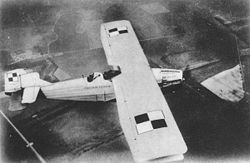Amiot 120
| Amiot 120 | |
|---|---|
 Amiot 123 "Marszałek Piłsudski" for transatlantic flights 1928/29 |
|
| Type: | Bomb and long-range aircraft |
| Design country: | |
| Manufacturer: | |
| First flight: |
1925 |
| Number of pieces: |
> 90 |
The Amiot 120 was a series of French aircraft that were built by SECM-Amiot from the mid-1920s. The best known are the Amiot 122 BP3 bomber and the Amiot 123 long-haul aircraft .
development
The Amiot 120 was designed as a single-engine biplane bomber. The first prototype was the Amiot 120 BN2 , a two-seat bomber with a Renault 12Ma 580 hp engine (registered as F-AHCR). It was not bought by the French Air Force . The Amiot 122 from 1927 with a Lorraine 18Kd 650 hp engine was more successful . It finally went into production as a three-seater version of the Amiot 122 BP3 . 80 machines went to the French Air Force and five machines to Brazil .
Another variant was the Amiot 123 BP3 , but the French Air Force showed no interest. Polish officials showed interest in this long-haul aircraft for a transatlantic flight. Two variants for long-distance flights were created in 1928/29. Both had a Lorraine 18 Kdrs engine, the first with 710 hp and the second with 785 hp.
The last variants were the Amiot 124 BP3 and Amiot 125 BP3 bombers from 1931 with the engines Hispano-Suiza 18Sbr (1000 hp) and Renault 18Jbr (700 hp).
Some sources state that there were still prototypes of the Amiot 121 with a Lorraine 18 Kd (650 hp) engine and the Amiot 126 with a Lorraine 18 Gad (700 hp)
use
The Amiot 122 was first used as a long-range sport aircraft. On September 13, 1927 there was a long-haul flight around the Mediterranean with the stations Paris , Vienna , Beirut , Cairo , Tunis , Casablanca and again Paris. The distance was 10,800 km. On April 3, 1928, Lieutenant Girardot flew over the Sahara to Paris, Timbuktu , Dakar and back to Paris over 10,100 km.
80 Amiot 122 BP3s were used in the French Air Force in Metz from 1930 . She was nicknamed La Grosse Julie .
In Brazil, five Amiot 122s (according to Brazilian sources: 4) were in service until 1936. One machine was used in a coup attempt in July 1932.
Polish transatlantic flight attempts
The first Amiot 123 was bought by the Polish Air Force for a transatlantic flight. The aircraft was named Marszałek Piłsudski (Marshall Piłsudski ). The crew were the pilot Ludwik Idzikowski and the navigator Kazimierz Kubala. The first attempt started on August 3, 1928 from Paris- Le Bourget at 4:45 a.m., but the flight had to be aborted after 3,200 km because the oil tank had a leak. They had to turn around halfway through and fly against the wind. Finally, after a 31-hour flight, the engine gave up 70 km off the Spanish coast and they had to make an emergency landing. The German merchant ship Samos rescued the two planes and pulled the plane on board.
Idzikowski and Kubala repeated the attempt in 1929 with the second Amiot 123. It took off on July 13, 1929 at 3:45 in the morning from Le Bourget. After a flight of 2,140 km there was engine malfunction and engine noise. Idzikowski first decided to land on Faial Island in the Azores , but then decided to go to the rocky Graciosa Island . On landing, the plane crashed into a rock and Idzikowski was killed. Kubala was only slightly injured. The plane burned during the rescue operation.
description
- Double decker with metal frame made of duralumin
- Engine cover also made of duralumin
- fixed chassis
Technical specifications
| Parameter | Data (Amiot 122 BP3) |
|---|---|
| crew | 3 |
| length | 13.72 m |
| Wingspan | 21.50 m |
| Wing area | 95 m² |
| height | 5.15 m |
| drive | 1 × Lorraine-Dietrich 18Kd, 650 PS (478 kW) |
| Top speed | 212 km / h |
| Range | 1000 km |
| Service ceiling | 6,200 m |
| Empty mass | 2800 kg |
| Takeoff mass | 4200 kg |
| Armament | 2 × 7.7 mm MG rigid, 2 × 7.7 MG, 590 kg bombs |

